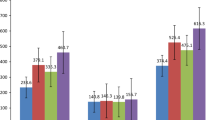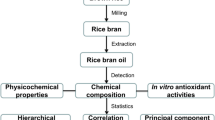Abstract
For the increase of oxidative stability and phytonutrient contents of rapeseed oil 5, 10 and 20 % blends with rice bran oil and black cumin oil were prepared. Profiles of different bioactive lipid components of blends including tocopherols, tocotrienols, phytosterols and phytostanols as well as fatty acid composition were carried out using HPLC and GLC. Rancimat was used for detecting oxidative stability of the fatty material. The blends with black cumin seed oil characterized higher level of α- and γ-tocopherols as well as all isomers of tocotrienols. Presence of rice bran oil in blends leads to increased tocotrienols amounts, β-sitosterol and squalene. Blending resulted in lowering ratio of PUFA/SFA and improves stability of these oils. The ratio of omega-6/omega-3 raises from 2.1 in rapeseed oil to 3.7 and 3.0 in blends with black cumin and rice bran oils, respectively. Addition of 10 and 20 % of black cumin and rice bran oils to rapeseed oil were influenced on the oxidative stability of prepared blends. The results appear that blending of rapeseed oil with black cumin seed oil or rice bran oil enhanced nutritional and functional properties via higher oxidative stability as well as improved phytonutrient contents.

Similar content being viewed by others
References
AOCS Official Method Cd 12b-92 (1997) Oil stability index. sampling and analysis of commercial fats and oils. methods and recommended practices of the American Oil Chemists’ Society, 4th ed., American Oil Chemists’ Society, USA
AOCS Official Method Ce 1k-07(2007) Direct methylation of lipids for the determination of total fat, saturated, cis-monounsaturated, cis-polyunsaturated, and trans fatty acids by chromatography. official method and recommended practices of the American Oil Chemists’ Society, 5th ed., 2007, American Oil Chemists Society, USA
AOCS Official Method Ch 6-91(1997) Determination of the composition of the sterol fraction of animal and vegetable oils and fats by TLC and capillary GLC. Official methods and recommended practices of the American Oil Chemists’ Society, 4th ed., American Oil Chemists’ Society, USA
Balz M, Schulte E, Their HP (1992) Trennungvon tocopherolen und tocotrienolen durch HPLC. Eur J Lipid Sci Technol 94:209–213
Blekas G, Boskou D (1989) Effect of β-sitosterol and stigmasterol on the rate of deterioration of heated triacylglycerols. In: Charalambous G (ed) Frontiers of flavor. Elsevier, Amsterdam, pp 403–408
Chin KY, Mo H, Soelaiman IN (2013) A review of the possible mechanisms of action of tocotrienol—a potential antiosteoporotic agent. Curr Drug Targets 14:1533–1541
Choe E (2008) Effects and mechanism of minor compounds in oil on lipid oxidation. In: Akoh CC, Min DB (eds) Food lipids. CRC Press Taylor & Francis Group, Boca Raton FL, pp 449–474
Choudhary M, Grover K, Kaur G (2013) Fatty acid composition, oxidative stability and radical scavenging activity of rice bran oil blends. Int J Food Nutr Sci 2:33–43
Choudhary M, Grover K, Kaur G (2015) Development of rice bran oil blends for quality improvement. Food Chem 173:770–777
Cleland LG, James MJ, Proudman SM (2003) Omega-6/omega-3 fatty acids and artritis. In: Simopoulos AP, Cleland LG (eds) Omega-6/omega-3 essential fatty acid ration: the scientific evidence, vol 92. World Review of Nutrition and Dietetics. S. Karger Publisher, Basel, pp 152–168
Cusak LK, Fernandez ML, Volek JS (2013) The food matrix and sterol characteristics affect the plasma cholesterol lowering of phytosterols/phytostanol. Adv Nutr 4:633–643
FAO Fats and Fatty Acids in Human Nutrition (2010) Report of an expert consultation. FAO Food and Nutrition Paper 91, Rome
FAO Statistical Yearbook (2013) World food and agriculture. Food and Agriculture Organization of the United Nations, Rom
Fatemi SH, Hammond EG (1980) Analysis of oleate, linoleate and linolenate hydroperoxides in oxidized ester mixtures. Lipids 15:379–385
Frankel EN, Huang SW (1994) Improving the oxidative stability of polyunsaturated vegetable oils by blending with high-oleic sunflower oil. J Am Oil Chem Soc 71:255–259
Gylling H, Hallikainen M, Raitakari OT, Laakso M, Vartianen E, Salo P, Korpelainen V, Sundvall J, Miettinen TA (2009) Long-term consumption of plant stanol and sterol esters, vascular function and genetic regulation. Br J Nutr 101:1688–1695
Hassanien MMM, Abdel-Razek AG, Rudzińska M, Siger A, Ratusz K, Przybylski R (2014) Phytochemical contents and oxidative stability of oils from non-traditional sources. Eur J Lipid Sci Technol 116:1563–1571
Hoffmann M, Świderski F, Zalewski S, Berger S (2002) Frying performance of rapeseed–palm oil blends. Pol J Food Nutr Sci 11:65–71
Kannappan R, Ravindran J, Prasad S (2010) Gamma-tocotrienol promotes TRAIL-induced apoptosis through reactive oxygen species/extracellular signal-regulated kinase/p53-mediated upregulation of death receptors. Mol Cancer Ther 9:2196–2207
Karupaiah T, Sundram K (2013) Modulation of human postprandial lipemia by changing ratios of polyunsaturated to saturated (P/S) fatty acid content of blended dietary fats: a cross-over design with repeated measures. Nutrition J 12:122–132
Kritchevsky D (1997) Phytosterols. In: Kristchevsky B (ed) Dietary fiber in health and disease, vol 427. Plenum Press, New York, pp 235–242
Lerma-García MJ, Herrero-Martínez JM, Simó-Alfonso EF, Mendonça CRB, Ramis-Ramos G (2009) Composition, industrial processing, and applications of rice bran γ-oryzanol. Food Chem 15:389–404
Liang Y, Gao Y, Lin Q, Luo F, Wu W, Lu Q, Liu Y (2014) A review of the research progress on the bioactive ingredients and physiological activities of rice bran oil. Eur Food Res Technol 238:169–176
Matthaus B, Özcan MM (2011) Fatty acids, tocopherol, and sterol contents of some nigella species seed oil. Czech J Food Sci 29:145–150
Mendez E, Sanhueza J, Speisky H, Valenzuela A (1996) Validation of the rancimat test for the assessment of the relative stability of fish oils. J Am Oil Chem Soc 73:1033–1037
Miyazawa T, Shibata A, Sookwong P, Kawakami Y, Eitsuka T, Asai A, Oikawa S, Nakagawa K (2009) Antiangiogenic and anticancer potential of unsaturated vitamin E (tocotrienol). J Nutr Biochem 20:79–86
Mostafa RA, Moharram YG, Attia RS, El-Sharnouby SA (2013) Formulation and characterization of vegetable oil blends rich in omega-3 fatty acids. Emir J Food Agric 25:426–433
Muhlhausler BS, Ailhaud GP (2013) Omega-6 polyunsaturated fatty acids and the early origin of obesity. Curr Opin Endocrinol Diabetes Obes 20:56–61
Przybylski R, Eskin NAM, Mag T, McDonald B (2005) Canola/Rapeseed oil. In: Shahidi F (ed) Bailey’s industrial oil and fat products, 6th edn. Wiley, New York, pp 61–121
Reyes-Hernandez J, Dibildox-Alvarado E, Charo-Alonso M, Toro-Vazquez J (2007) Physicochemical and rheological properties of crystallized blends containing trans-free and partially hydrogenated soybean oil. J Am Oil Chem Soc 84:1081–1093
Schwartz H, Ollilainen V, Piironen V, Lampi AM (2008) Tocopherol, tocotrienol and plant sterol contents of vegetable oils and industrial fats. J Food Compos Anal 21:152–161
Sharma AR (2002) Edible rice bran oil—consumer awareness programme. Rice bran Oil Promotion Committee. Solvent Extractors Association of India, Mumbai
Simopoulos AP (1996) Omega-3 fatty acids. part I:—metabolic effects of omega-3 fatty acids and essentiality. In: Spiller GA (ed) Handbook of lipids in human nutrition. CRC Press Inc, Boca Raton, pp 51–73
Simopoulos AP (2002) The importance of the ratio of omega-6/omega-3 essential fatty acids. Biomed Pharmacother 56:365–379
Soehnlein O, Drechsler M, Hristov M, Weber C (2009) Functional alterations of myeloid cell subsets in hyperlipidaemia: relevance for atherosclerosis. J Cell Mol Med 13:11–12
Wirfält E, Mattisson I, Gullberg B, Johansson U, Olsson H (2002) Postmenopausal breast cancer is associated with high intakes of ω6 fatty acids (Sweden). Cancer Cause Contrl 13:883–893
Acknowledgments
This study was supported by international cooperation between the Egyptian Academy (National Research Centre, Fats and Oils Dept.), Polish Academy of Sciences and Poznań University of Life Sciences, Faculty of Food Science and Nutrition.
Author information
Authors and Affiliations
Corresponding author
Additional information
Research highlights
In the experimental part a new products were obtained—blends of plant oils
In the analytical part were investigated oxidative stability of blends
Blending of rapeseed oil with black cumin or rice bran oil increased their oxidative stability
Rights and permissions
About this article
Cite this article
Rudzińska, M., Hassanein, M.M.M., Abdel–Razek, A.G. et al. Blends of rapeseed oil with black cumin and rice bran oils for increasing the oxidative stability. J Food Sci Technol 53, 1055–1062 (2016). https://doi.org/10.1007/s13197-015-2140-5
Revised:
Accepted:
Published:
Issue Date:
DOI: https://doi.org/10.1007/s13197-015-2140-5




